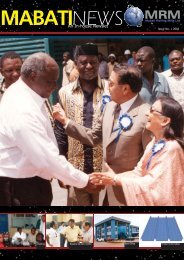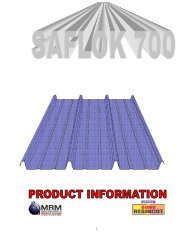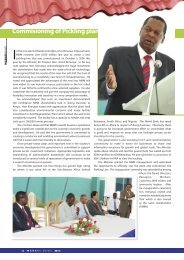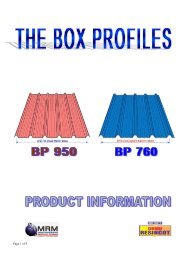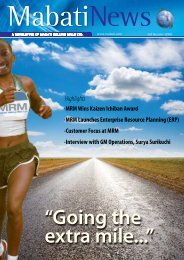Create successful ePaper yourself
Turn your PDF publications into a flip-book with our unique Google optimized e-Paper software.
ECONOMIC PARTNERSHIP AGREEMENTS<br />
By Antony Kung'u<br />
Background<br />
A special trade relationship has existed between the European Union<br />
(EU) and African Caribbean and Pacific group (ACP) of countries since<br />
1975 when the first Lome Convention was signed. Under the Lome<br />
Conventions, the ACP countries enjoyed unilateral trade preferences<br />
into the EU market. The Fourth Lome Convention was replaced by<br />
the Cotonou Agreement in 2000, which extends the unilateral trade<br />
preferences up to December 2007. Thereafter, the parties are dutybound<br />
to negotiate and conclude World Trade Organisation (WTO)<br />
compatible reciprocal trade agreements, the Economic Partnership<br />
Agreements (EPAs), at the beginning of 2008.<br />
The EPAs are touted as the new co-operative framework under the<br />
Cotonou Agreement and are expected to adopt an integrated approach<br />
based on partnership and promoting co-operation, multilateral trade<br />
and political dialogue between the EU and the ACP countries. The key<br />
features of EPAs are their reciprocity and non-discriminatory nature.<br />
They involve the removal of all trade preferences which have been<br />
established between the EU and the ACP countries since 1975 as well<br />
as the progressive removal of trade barriers between the partners. The<br />
EPAs are open to all developing countries thereby effectively bringing<br />
down the curtain on the ACP group as the main development partner<br />
of the EU.<br />
Regional Blocs<br />
Previously, the EU negotiated with all ACP countries as a bloc. However,<br />
for EPAs’ negotiations, the EU has split the ACP countries into trading<br />
blocs, arguably undermining their solidarity, negotiating power and<br />
political power thus weakening their overall bargaining power. The<br />
ACP countries have formed six regional configurations or groupings<br />
through which to negotiate EPAs with the EU, some of which arethe<br />
Southern Africa Development Community (SADC), the Eastern<br />
and Southern Africa group (ESA), the Caribbean Community and the<br />
Economic Community of West Africa (ECOWAS). Kenya belongs to the<br />
ESA configuration.<br />
Effects of EPAs on ACP Countries<br />
Although the EPAs are aimed at supporting the on-going processes<br />
of economic integration and gradual liberalisation of trade between<br />
ACP countries and the EU, some very legitimate concerns have been<br />
raised on their effects on the ACP countries. The EU has chosen to<br />
negotiate the agreements under strict WTO rules that govern reciprocal<br />
free trade agreements (FTAs), requiring ACP countries to open their<br />
markets to "substantially all" EU imports over a limited period of time.<br />
The 10-year period given by EU to ACP countries to open their markets<br />
to substantially all trade is not adequate for the latter to develop their<br />
productive capacities and strengthen their competitiveness prior to<br />
the potential influx of EU products into the ACP markets. Inequalities<br />
resulting from the different levels of development between the EU<br />
and ACP countries make reciprocity untenable. The ACP countries also<br />
face a gargantuan task in their zeal to break into EU markets already<br />
dominated by long established, well loved and highly patronised<br />
European brands. Local producers lacking distinctive capabilities will<br />
not survive the potential onslaught to be waged by cheap imports<br />
from the EU. Furthermore, the EU is bound to apply stringent rules of<br />
origin (ROO) on imports from ACP countries, thus introducing technical<br />
barriers to market access.<br />
MABATINEWS<br />
Profiling lines at CGL Mariakani<br />
By Gabriel Olukwo<br />
As part of its modernization and<br />
equipment u<strong>pg</strong>rading program in line<br />
with the developments in technology,<br />
<strong>MRM</strong> has installed and commissioned three<br />
profiling lines at the finishing department of<br />
the Continuous Galvanizing Line at Mariakani.<br />
Profiler 1 was commissioned in July 2004,<br />
while profilers 2 and 3 were commissioned<br />
in October 2006. These lines have replaced<br />
shearing lines and barrel corrugators. The<br />
profiling lines produce galvanized and<br />
aluminium-zinc coated corrugated standard<br />
profile sheets. These profiling lines and<br />
their layout are in line with Gemba Kaizen<br />
principles of lean manufacturing. Material<br />
and crane movement have been greatly<br />
reduced. Three processes have been<br />
combined into one. The order execution time<br />
has been reduced and the products from<br />
these lines do not have any variations. The<br />
profiling lines are far much superior to barrel<br />
corrugators in many ways. A higher range of<br />
materials can be processed on profilers. They<br />
can accommodate 0.20mm to 0.30mm thick<br />
material with minimum adjustments. Sheets<br />
of various lengths are produced ranging from<br />
a few centimetres to over 10 metres length<br />
to meet customer requirement. The<br />
profiling lines also produce sheets with<br />
uniform profiles. These profilers are highly<br />
automated with minimal setting time and<br />
once correct settings have been achieved, the<br />
profilers run automatically producing scratch<br />
free sheets. Since profiling lines combine<br />
three processes, (shearing, handling and<br />
corrugation), rejections are fewer and orders<br />
can be executed exactly as per requirements.<br />
Profiling lines occupy less space and do not<br />
require storage for cut plain sheets. Each<br />
Profiling line is manned by only five persons<br />
compared to 11 persons in barrel corrugators<br />
(three at shearing and eight at corrugator).<br />
Production cost of profiling lines is lower than<br />
that of lines with barrel corrugators because<br />
less manpower is utilised and less power is<br />
consumed. The profiling lines have a very<br />
high safety level as the operation position<br />
is far from moving parts and there is no<br />
manual feeding of sheets into the profiler. The<br />
operation is thus less tiresome resulting to<br />
decreased human errors as a result of fatigue.<br />
The noise levels at profiling lines are very low<br />
hence operators are not required to wear ear<br />
plugs or muffs.<br />
Conversely, barrel corrugators<br />
process only one gauge and a<br />
maximum sheet length of 3.7 metres. As<br />
the production process entails shearing,<br />
transfers and finally corrugation the rejection<br />
level is high because of the independent<br />
multiple processes involved. Continuous<br />
manual feeding leads to over dependency on<br />
humans. These lines are prone to accidents<br />
because of multiple handling of products,<br />
operation is near to moving parts and their<br />
inherent prolonged human fatigue. Lines<br />
with barrel corrugators occupy a lot of floor<br />
to accommodate the shearing lines, extra<br />
storage space for work in process plain sheets<br />
and the barrel corrugators. The noise levels at<br />
barrel corrugators are high and the operators<br />
must wear ear plugs or muffs for hearing<br />
protection.<br />
M A B A T I N E W S 15



